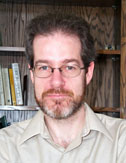|

Comment
on this story
|
 |

by Massimo Pigliucci
Imagine you are about to have a mystical experience, that you are about to experience a feeling of unity with the universe, an experience that will reinforce your conviction that there really is another world out there. The question is: What is going on in your brain while all this is happening? Are your mental powers, in fact, allowing you to, at least temporarily, gain a higher view of the universe? Or, is your brain simply malfunctioning under unusual circumstances and playing tricks on you? In the following, I will lay out the evidence as best as we can assess it.
Andrew Newberg and Eugene D'Aquili, two researchers interested in the neurobiology of mystical experiences, carried out an intriguing set of experiments. They asked Buddhist meditators and Franciscan nuns, respectively, to try to achieve a state of deep meditation or prayer while in an isolated room in a laboratory. The subjects were hooked to a computerized scanning machine that could visualize which parts of their brains were unusually active or in-active. The results were very similar in the two cases. For one thing—and not surprisingly—the brains of the meditators and nuns activated areas that are associated with intense concentration: praying or meditating is an intellectual activity that requires effort on the part of the brain. More interestingly, Newberg and D'Aquili saw that another region of the brains of their subjects was going almost completely dead: the posterior superior parietal lobe. This area is known to be in charge of determining the boundaries of one's body, a fundamental task for any living being because it allows us to navigate a complex three-dimensional world with no more accidents than occasionally spilling the coffee.
We know that the posterior superior parietal lobe plays that particular role because there are patients with damage in this same region who literally cannot move around without falling, missing the chair they intended to sit on and generally having a fuzzy understanding of where their body ends and the rest of the universe begins.
Now, what is interesting is that Newberg and D'Aquili's subjects described their mys-tical experience in an uncannily similar way to the reports of brain-damaged patients: they said that, at the peak of their meditation or prayer, they felt "one with the universe," feeling a dissolution of their bodies into the wholeness of reality. The brain scans supported their interpretation of what was happening: because of the low level of sensorial stimuli (the experiments were being conducted in dark rooms with no sounds) the brain was fed little in the way of information about the outside world and simply shut down the corresponding areas (possibly to save energy: the brain is by far the meta- bolically most costly organ we have).
The question is: were the Franciscan nuns and Buddhist meditators really accessing an alternate reality, or were they simply experiencing an odd side effect of putting their brains under unusual circumstances?
Michael Persinger is a Canadian neurobiologist who, like Newberg and D'Aquili, is interested in scientifically investigating mystical experiences. He has started out with the known fact that some patients who suffer from seizures in the temporal lobes are subject to auditory or visual hallucinations, which they often interpret as mystical experiences. Some of these patients are convinced that they talked to God and that, as a result, they gain a special "cosmic" insight into reality, consciousness, and the meaning of life. Persinger set out to literally repeat these experiences under controlled laboratory conditions. He built a helmet that causes small intense, and directed magnetic fields inside the brain to simulate micro-seizures that do not cause any permanent damage. In perfectly Victorian tradition, the good doctor has experimented upon himself and found that magnetically induced seizures in the temporal lobes do indeed generate the same sort of hallucinations and mystical experiences reported by the patients.
Again, what is going on? Is Persinger's helmet a machine that can put everybody in direct contact with God, or does it show that many mystical experiences are in fact caused by seizures, by a malfunction of the normal brain circuitry?
Here is where the facts end and the theorizing begins. From the point of view of purely logical possibilities, the "faulty-brain-under-unusual-circumstances" and the "triggered-real-mystical-experiences" interpretations are both possible, and we are free to believe whatever fits better with our general outlook on such matters. However, I would argue that by far the simplest and most reasonable explanation of the facts is indeed the naturalistic one (i.e., a temporary malfunction of the brain triggered by abnormal conditions such as sensorial deprivation or seizures). Why? First, this interpretation fits with all we know about the brain, the phenomenon of hallucinations and even the natural tendency of human beings to invent explanations when faced with unusual data. Second, if God really built that ability in our brains for the purpose of communicating, why did He choose to make it much easier for some individuals and essentially impossible for others to achieve such a state of blessing? Third, it is interesting that different subjects interpret their experiences differently, depending on their cultural background and previous beliefs, again something that fits better with a naturalistic explanation than with the refined plan of a supernatural being.
Either way, you'll have to use your brain to reach a conclusion. But how do you know that you're not having a seizure that is biasing your judgment? Isn't the human brain a wonderful thing to ponder with and about?

July 25, 2002 * Vol. 12, No. 30
© 2002 Metro Pulse
|